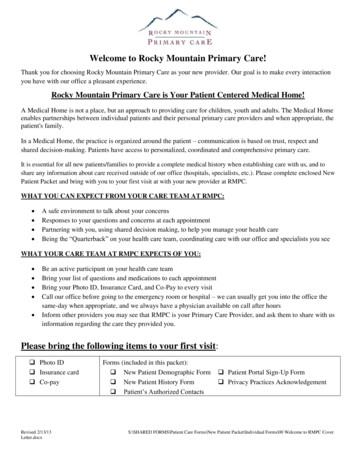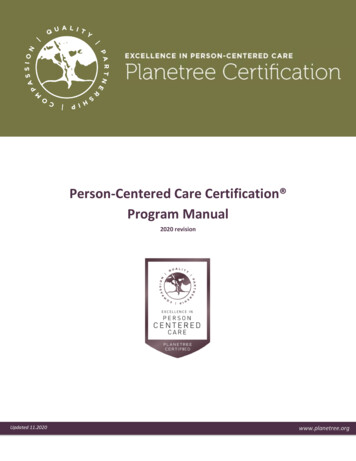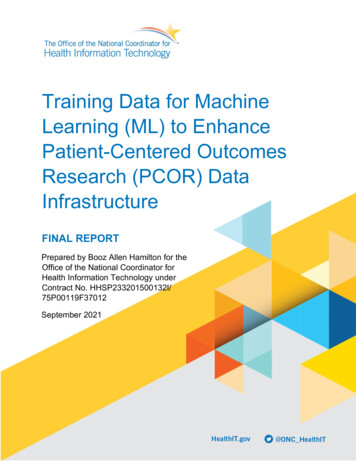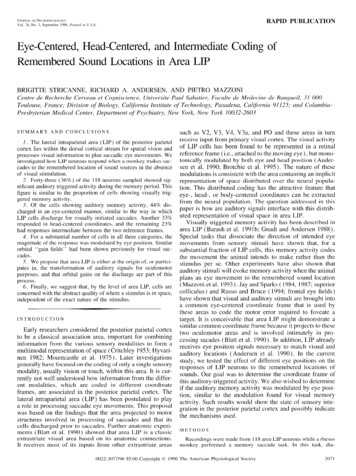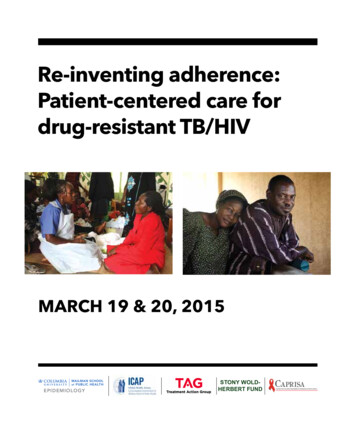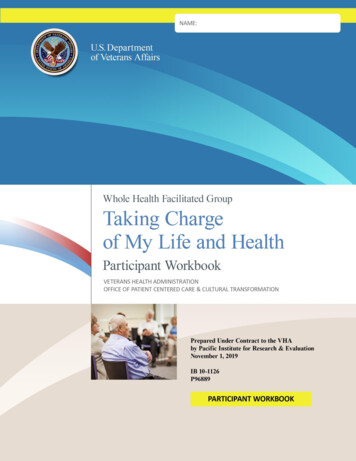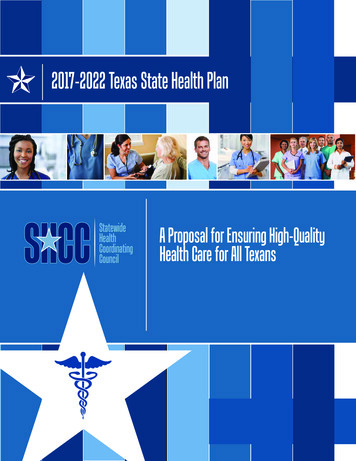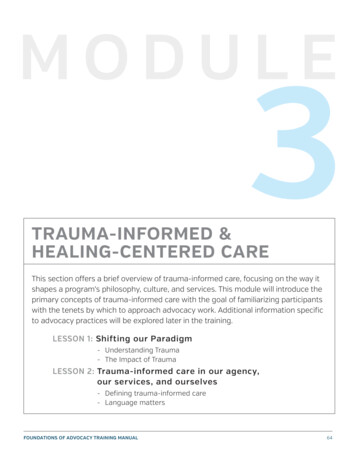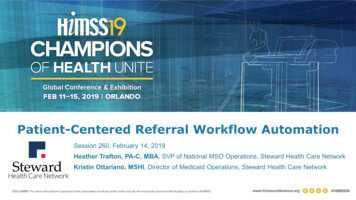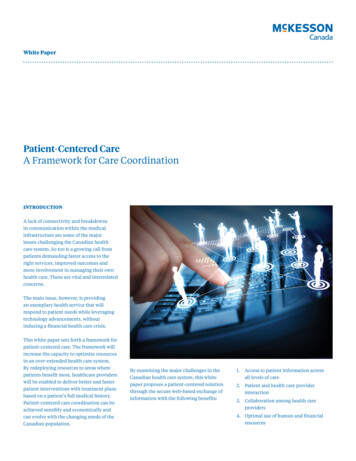
Transcription
White PaperPatient-Centered CareA Framework for Care CoordinationINTRODUCTIONA lack of connectivity and breakdownsin communication within the medicalinfrastructure are some of the majorissues challenging the Canadian healthcare system. So too is a growing call frompatients demanding faster access to theright services, improved outcomes andmore involvement in managing their ownhealth care. These are vital and interrelatedconcerns.The main issue, however, is providingan exemplary health service that willrespond to patient needs while leveragingtechnology advancements, withoutinducing a financial health care crisis.This white paper sets forth a framework forpatient-centered care. The framework willincrease the capacity to optimize resourcesin an over-extended health care system.By redeploying resources to areas wherepatients benefit most, healthcare providerswill be enabled to deliver better and fasterpatient interventions with treatment plansbased on a patient’s full medical history.Patient-centered care coordination can beachieved sensibly and economically andcan evolve with the changing needs of theCanadian population.By examining the major challenges in theCanadian health care system, this whitepaper proposes a patient-centered solutionthrough the secure web-based exchange ofinformation with the following benefits:1.Access to patient information acrossall levels of care2. Patient and health care providerinteraction3. Collaboration among health careproviders4. Optimal use of human and financialresources
Focus on Patient needsA key change that has to be made is one thatcountless parties trumpet as positive andeasy-to-implement: patient-centered care. It isan essential component of any plan to reducehealthcare costs. And it satisfies the pressingneed for patients to have a more active andempowered role in the treatment of their ownhealth and that of their loved ones.CURRENT HEALTH CARE CHALLENGESEscalating CostsThe Fraser Institute noted in 2011, “acrossCanada, government spending on healthhas grown faster (8.1% annually) on averagethan GDP (6.7% annually) since 1975. As of2011, provincial health spending in Ontarioand Quebec currently consumes more than50% of total revenues.” iInefficient use of ResourcesThere are numerous reasons for theescalating costs, including duplicate testingand medication errors due to an inabilityto share patient information, poor handoffs between levels of care resulting frominefficient methods of communication andan inability to coordinate care for patients.The latter often causes redundant andexpensive tests and prescriptions as well asother unnecessary costs as a result of a lackof consolidated medical information aboutthe patient.Access to Patient InformationRichard Alvarez, President & CEO of CanadaHealth InfoWay, noted: “Astonishingly,every year almost all of the 100 millionphysician exams, half a billion laband radiology tests, and 382 millionprescriptions [in Canada] are handwritten.This critical information – buried in thefiling rooms of 40,000 doctor offices, testcentres, hospitals and clinics – is ofteninaccessible in crisis situations, when it isneeded most. There are many reasons thisantiquated approach cannot continue. Itputs our safety at risk, and wastes moneyand scarce resources. It undermines everyhealthcare priority we have.” iiPatient SafetyMore troubling is the effect on patientsafety. “Each year, between 9,000 and24,000 Canadians die from adversemedical events,” the Ivey Centre for HealthInnovation and Leadership reported.“By avoiding duplication of systeminformation via common health recordscontaining all patient documentation,practitioners can have more time withpatients and families while minimizingerrors due to misinformation or gaps ininformation transferred between healthteam members.” iii2POSSIBLE SCENARIOA woman in her late forties, who travelledconsiderably, became ill on a business tripand was unable to communicate with theemergency workers at the hospital to whichshe was taken by ambulance.The attending doctor determined thatshe required several drugs, but he hadno idea as to whether she was allergic toany of them or if they were safe to take incombination with medications she mightalready be on. One that he wanted toadminister could have serious side effectsif combined with several common heartmedications.The doctor also noted the woman hadseveral herbal remedies in her purse andwondered how many others she might betaking. Some herbal products can reactnegatively with certain medications.Frustrated, he wished it were possibleto access her medical records online toalleviate any risk he might have to take.Ultimately, he determined it was moreimportant to administer the drugs sherequired and gave them to her. Fortunately,no problems ensued.This scenario is a daily reality for ourCanadian emergency physicians. Thedifficulties they face are directly linked tothe challenges in the Canadian health caresystem. The use of information technologycan play a critical role to overcome thesechallenges and create a patient-centeredapproach to health care.THE HEALTH CARE SOLUTIONOne solution to the “impending healthcrisis” is to embrace “change faster andin greater capacities than ever before,”concludes the Ivey Centre’s report.In July 2011, the Canadian Medical Association(CMA) and the Canadian Nurses Association(CNA) echoed that conclusion in a jointlyreleased Principles to Guide Health CareTransformation in Canada.At the top of their list was a call to develop asystem that is universal, sustainable and trulycentred on the needs of patients. The systemneeds to be transformed into one that putspatients first.Such a system must provide patients with“seamless access to the continuum of care basedon their needs.” ivAdoption of TechnologyDespite Canada’s reputation as a leader in healthcare, Canada lags behind other countries in itsadoption of technology in the health care sector.“Overall, adoption rates of simple tools, likeelectronic medical records (EMRs) in privatemedical practice settings across Canada are stillvery low – in the range of 37 per cent,” says RonDunn, Vice President, Information Solutions atMcKesson Canada. “There are 140,000 familyphysician consults per day in Ontario, comparedto 3,000 visits per day in hospitals. Yet mostIT investments have been at the hospital orprovincial level, not the patient level. This issimply not sustainable. We need to take a morepatient-centered approach to health care, andtechnology is a vital part of the solution.”Both the Canadian Medical Association andCanada Health InfoWay echo those observations.In its report Healthcare Transformation inCanada, the CMA noted that health careinformation technology must shift from multibillion dollar investments at the hospital levelto a renewed emphasis at the patient level(family physician consults) where the majority ofCanadian patients interact with the healthcaredelivery system.The report states that existing top-downinvestments have not yet resulted in significantbenefits to providers or patients because
Canadians are increasingly demandingaccess to their health records and greaterinvolvement in managing their own healthconcerns.jurisdictions have focused their investmenton large-scale Health InformationTechnology (HIT) systems and architecture.There has been little investment at thepoints of care where the actual benefits ofHIT can be realized.Effective CommunicationHOW EXACTLY DOES PATIENTCENTERED CARE WORK?Achieving genuine patient-centeredcare requires a cultural adjustment, theconsulting firm wrote. Its list of essentialactions providers must embrace if patientcentered care is to be achieved includedthe need to embrace “e-health and othertechnologies that expedite communication,flow, and efficiency.” vImproved communication between patientsSupportive Information Technologyand clinicians is a key element of patientcentered care. For too long, the dialoguebetween the parties has been somewhatparental. The clinician, often leafingthrough a folder that contains a patient’sinformation, would suggest or prescribetreatments in an all-knowing manner,like a parent to a child. Rarely, if ever, wasthe patient allowed to see what was in thefolder. If that did occur, the access waslikely limited to whatever sections theclinician decided were appropriate to view.Patient RequirementsIn 2009, Steven Lewis Access Consultingof Saskatoon produced a discussionpaper for the Saskatchewan Ministry ofHealth entitled Patient-Centered Care:An Introduction to What It Is and How toAchieve It. The paper cited work conductedby The Change Foundation, an Ontariohealthcare think tank, which has longadvocated patient-centered care. TheFoundation conducted a series of focusgroups to get a better understanding of thepatient experience.Modern technology allows for thatrelationship to radically change. TheCommonwealth Fund, a private U.S.foundation that promotes high-performinghealthcare systems, commissioned astudy by Shaller Consulting called PatientCentered Care: What Does it Take? Releasedin October 2007, the report, which wasbased in interviews with leaders of patientcentered organizations, identified sevenkey factors for achieving patient-centeredcare in their workplaces. One of the sevenwas “supportive information technology.”Physician-Patient PartnershipsShaller said that supportive healthcaretechnology permeated virtually all theother six elements. “[It] engages patientsand families directly in the care processby facilitating communication with theircaregivers and by providing adequateaccess to needed information and decisionsupport tools. Numerous applicationsof health-information technology haveemerged in recent years, from simple e-mailcommunication between patients andclinicians to more sophisticated patientWeb portals that enable patients to interactwith their physicians’ electronic medicalrecords.”Most of the experts Shaller interviewed“agreed that supportive informationtechnology is generally underused and thatorganizations at the forefront of developingpatient-centered HIT applications aredemonstrating that they can enhancephysician-patient partnerships in care.” viOne the Foundation’s key findings wasthat patients required functioning e-healthsystems to: Ensure that patients only need to provideinformation once Ensure that it is accessible to those whoneed it Give patients access to their records Provide the opportunity to add to theinformation3
If it is a given that patient-centered care isthe optimal model for today and tomorrow’shealthcare system in Canada, then it mustalso be true that an essential component ofthat model is the use of modern technology toachieve that end.THE RELAYHEALTH SOLUTIONSecure, web-based informationexchangeMcKesson Canada believes that patientcentered care is a partnership betweendoctor and patient based on clearcommunication, trust, sharing information,empowerment and coordinating care acrossthe health system.In November 2011 McKesson Canadalaunched RelayHealth in Canada, asimple, accessible web-based interfacethat provides complete and secureinformation flow between patients andall their healthcare providers, includingphysicians, laboratories and hospitals,wherever located. It is a patient-centeredcare solution, which is powerful, quicklydeployed and a cost-effective tool.RelayHealth is offered free of charge topatients with an email address and Internetaccess.Already operational since 2000 throughoutthe U.S. where more than 24 millionpatients and 40,000 physicians use it,RelayHealth is the first interactive servicethat allows providers and patients tocommunicate electronically on a number ofessential medical and health matters.Patient & Provider InteractionPatients, for example, can ask clinicalquestions via secure messaging, receivepreventive care reminders, send a note tothe provider’s office, request prescriptionrenewals and refills, request lab or testresults, and request appointments. Theycan also securely store and manage theirpersonal health record (PHR) information,including health conditions, allergies,immunizations, hospitalizations, officevisits and their family health history.4Increasingly, patients have made it clearthey want tools to manage their owncare and that of their dependents. Thislatter point is particularly important asthe population continues to age, andmore adult children have elderly parentssuffering from chronic ailments that requireongoing treatment.A significant attribute of RelayHealth isthat it allows patients to contact a healthprovider at any time, without having tomake an appointment, travel to the healthfacility and then wait to see the provider.Obviously, in-person visits will still needto occur, however, often, the patient’sconcerns can be alleviated without havingto attend a facility.At the U.S. Army Regional Medical Centerin Landstuhl Germany, RelayHealthwas recently tested to determine itseffectiveness. “We think it’s more patientfriendly,” reported Capt. Rob Davis, DeputyChief, Clinical Operations. “They’ll beable to send us messages when it’s moreconvenient for them. But also we’ll beable to respond to them in a more timelyfashion. It’s been nice being able to alleviatesome parents from having to bring kids in,and in pediatrics specifically. We’ve hadgood feedback so far.”Collaboration Among ProvidersProviders can easily request referrals,coordinate care, send messages andexchange records with other healthcareproviders with appropriate authorization.They can prepare and send reminders,alerts and other crucial information.When treating patients they can augmentinformation and instructions online thatare often too detailed to impart duringan office visit, from routine diagnosticsto critical care for life-threatening issues.Patients can quickly and easily learn aboutchronic conditions, routine ailments andprocedures using resources offered in a widevariety of formats. These include electronicdocuments, digital animations and multimediaprograms and information on more than 5,000medical conditions and procedures and over6,000 medications.Joseph Galli, Director and co-founder of theCanadian Loeys-Dietz Syndrome Foundationin Montreal, says that RelayHealth is a trulyinnovative service that “fosters proactivecollaboration between the different medicalproviders, allowing patients to have one touchpoint for all of their health needs. RelayHealthwill help health organizations, governments andinstitutions to improve patient health outcomes,integrate health information, and deliveraccessibility and cost efficiencies.”Records ManagementThe benefits of a service that stores patienthealth records electronically are both immediateand long-term. One example of the formerinvolves a patient’s medication history. It is notuncommon for a patient who is seeing severalproviders to have duplicate prescriptions, someof which have lapsed. Frequently medicationsshould not be taken in conjunction with otherexisting prescriptions. When this informationis viewed on an ongoing basis by the patientand all caregivers, it can eliminate unnecessaryover-prescription and possibly prevent negativehealth outcomes resulting from prescribingcontraindicated medication.Mississippi Health Partners (MHP), a managedcare organization, has provided an exampleof the long-term benefits. “Natural disasters,like Hurricane Katrina and recent tornados,destroyed lives and businesses and homesand left thousands without proper healthrecords,” an MHP spokesperson said in anonline video. “Many people could not remembertheir medication and immunization historiesand some even lost all records of their healthproblems. Having an online PHR makes sure thisdoesn’t happen to you.”Security and PrivacySecurity and privacy are undeniably criticalconcerns for all providers considering adoptinga service such as RelayHealth, as they are forpatients. Unlike email, which relies on multiplefile servers distributed across the Internet,RelayHealth uses a single, centrally managed,secure database for all provider-patientcommunications. All messages are delivered toa Web browser using 128-bit, secure-socket layerencryption.
While RelayHealth empowers patients toparticipate in their own healthcare in a newand advanced way, it also allows providers toenhance collaboration and share data withothers in the medical community.A patient’s information remains completelyconfidential and secure and is protectedunder Canada’s Personal InformationProtection and Electronic DocumentsAct and Privacy Act, as well as provincialProtection of Privacy Acts.Providers, however, need not be concernedthat everything in a patient’s file will beaccessible to the patient. The service ismodular. In certain instances subjectivenotes that a physician might have madeconcerning a patient’s treatment canbe kept separate from the informationavailable to the patient.Customized SolutionsWhile it is possible for each provider andhealth care authority to create its ownhealth information exchange system,the investment in time, money andmaintenance to do so is far greater thanusing a proven, centralized system such asRelayHealth.There are components and pieces of healthinformation technology in existence,but RelayHealth is the first service thattruly integrates all of a patient’s healthinformation and allows health careproviders to communicate and collaboratewith their peers at every point in a patient’scare, as well as with their patients.It would take years for hospitals or otherproviders to build and realize the benefitsof large-scale Health Information Exchangesystem. With the urgency to improvepatient outcomes, purchasing an existingservice seems to be a far more efficient andcost-effective solution than building andmaintaining a myriad of new ones.RelayHealth is affordable for even thesmallest health region, hospital orclinic. It improves care coordinationfor better outcomes, maximizes use ofcurrent systems and workflows, improvesaccessibility to patients and other providersand increases staff productivity and patientsatisfaction.“The advantage of using this solution is thatit achieves savings and better service in theshorter term for the health care system andit will help increase patient satisfaction,”says Dale Weil, Senior Vice President,Integrated Healthcare Solutions, Strategyand Business Development of McKessonCanada. “Also, because RelayHealthis delivered as a web-based service, itaccelerates implementation and is providedat a lower cost than other major healthinformation technologies. It is a convenientservice that provides the same view andsame patient information across the entirehealth network.”CONCLUSIONRelayHealth: A Patient-CenteredApproach that WorksPhysicians who have more personalizeddiscussions with patients and encouragethem to take a more active role in theirhealth care can help lower medical costsand reduce the need for some health careservices, according to a 2011 UC Davis study.“What’s been termed patient-centered carecan help eliminate or reduce unnecessaryand costly testing and referrals tospecialists,” says family physician KleaBertakis and study co-author RahmanAzari, a professor of statistics at UC Davis.Patients are increasingly challenging theestablished medical system to become moreinteractive. The early supporters all sharethe view that informed, motivated patientsmust play a much greater role in managingtheir own health if the policy goals ofimproving the quality of care and curbingcosts are to be achieved.RelayHealth, as discussed in this paper,can help satisfy the growing call fromboth patients and providers for a newrelationship in Canada’s health care system.It allows all stakeholders to have connectedaccess to a patient’s medical history, at alltimes. Most importantly, RelayHealth is acost-effective solution that will redeployresources to where they are truly needed.Our health care crisis must be dealt witheffectively as soon as possible. “There is noillusory ‘tipping point’ where health carebecomes unmanageable,” the Ivey reportconcluded. “There is only the constantchallenge to provide better care and qualityof life for Canadians into the future.”One important strategy to improve thefuture of our health care system is toembrace technology-driven solutions thatcan address the primary challenges facedby the current health care environment.The RelayHealth solution is available nowand has proven to be an effective platformin the shifting paradigm of our health caresystem.Patient-Centered Care has been identifiedby the Institute of Medicine “as one of thekey actions for improving our nation’shealth,” says Bertakis. vii5
RelayHealth is a web basedservice that gives clinicians acomplete picture of a patient’smedical record, and enablesinteractions amongst caregivers at every point of caresuch as a doctor’s office,ER, hospital, or long-termcare facility. It allows careproviders and patients tosecurely collaborate andinteract to share test results,book appointments or makeelectronic referrals. It providespatients with the tools tomanage their own care andthat of their dependents.RelayHealth is a trusted,current and complete electronichealth record and informationsharing tool.BibliographyGerties Margaret, Edgman-Levitan Susan,Daley Jennifer and Delbanco Thomas L.:Through the Patient’s Eyes: Understandingand Promoting Patient-Centered Care.Jossey Bass, 1993Skinner Brett J., and Rovere Mark.Canada’s Medicare Bubble – Is GovernmentHealth Spending Sustainable without Userbased Funding? The Fraser Institute, April2011iAlvarez Richard: If Canadians WantTo Realize The Benefits Of ElectronicHealth Records, It’s Up To The PublicTo Demand Them. Available at y/article canadians.htmliiCanadian Medical Association: TowardPatient-Centered Care: Digitizing HealthCare Delivery: The CMA 5-Year Strategyfor Health Information Technology (HIT)in Canada. Canadian Medical Association(CMA), May 2011Snowdon Ann, Shell Jeremy and KellieLeitch K.: Transforming Canadian HealthCare Through Consumer Engagement:The Key to Quality and System Innovation.Ivey Centre for Health Innovation andLeadership, 2011iiiLewis Steven: Patient-Centered Care:An Introduction to What It Is and Howto Achieve It – A Discussion Paper for theSaskatchewan Ministry of Health. AccessConsulting Ltd. July 2009Bertakis, Klea D. and Azari Rahman:Patient-Centered Care is Associated withDecreased Health Care Utilization. Journalof the American Board of Family Medicine.May-June 2011, vol. 24, no. 3, 229-239CMA and the Canadian NursesAssociation: Principles to Guide HealthCare Transformation in Canada. July 2011Available at http://www.cma.ca/advocacy/hctprinciplesivLewis Steven: Patient-Centered Care:An Introduction to What It Is and Howto Achieve It. A Discussion Paper for theSaskatchewan Ministry of Health. AccessConsulting Ltd. July 2009vShaller Dale: Patient-Centered Care: WhatDoes it Take? Shaller Consulting, October2007viUC Davis study finds that “patientcentered care” lowers health care costs. UCDavis Health System, Centre for VirtualCare. Press Release, June 24, 2011viiMcKesson CanadaHead Office4705 Dobrin StreetSaint-Laurent, QuébecH4R 2P7RelayHealth Canada aCopyright 2013 McKesson CanadaAll rights reserved.
McKesson Canada. "There are 140,000 family physician consults per day in Ontario, compared to 3,000 visits per day in hospitals. Yet most IT investments have been at the hospital or provincial level, not the patient level. This is simply not sustainable. We need to take a more patient-centered approach to health care, and

